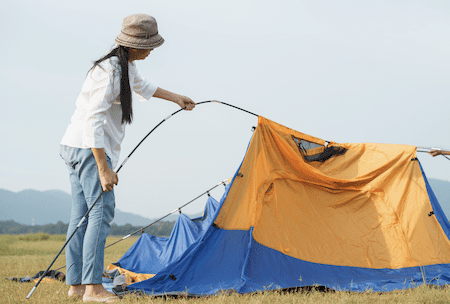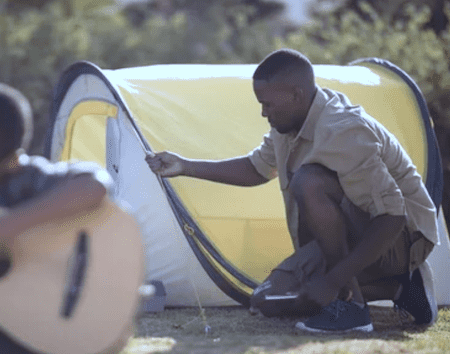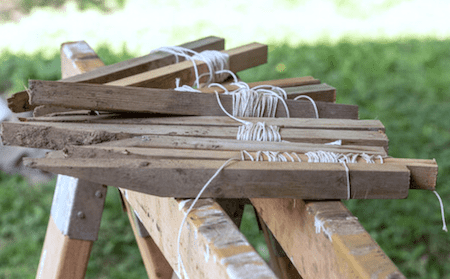If you’re like most people, you probably don’t leave home without your tent stakes. They are an essential part of setting up a tent, after all.
But what if you find yourself in a situation where you forgot to pack your stakes?
Or, worse yet, what if you discover that the campground you’ve arrived at doesn’t have enough solid ground for tent stakes to work?
You might be left wondering how to secure a tent without stakes.
Lucky for you, there are plenty of other ways to anchor a tent that can work in almost any camping environment.
In this article, I will walk you through the best ways to do it.
Do You Need Stakes For Securing A Tent?
The answer to this question is entirely dependent on the conditions around your campsite.
For example, if you are setting up your tent on hard ground or there are heavy wind gusts, it will be necessary to use stakes to help anchor your tent and keep it secure.
In contrast, when you’re camping in a large, open area, you don’t need a whole lot to set up camp.
As long as the weather is calm and the ground is relatively soft, you can just throw your tent on the ground and enjoy the night under the stars.
Still, as far as a tent’s stability is concerned, a tent with stakes is always more reliable than one without any.
3 Simple Methods To Secure A Tent Without Stakes
#1. Weighing Down The Tent
First, and by far the most popular alternative to pitching a tent without stakes, is to weigh it down.
Ideally, using rocks, firewood, or logs as tent weights around the campsite should help your tent stay firmly in place.
If you wish, you can try this same technique for securing canopies, gazebos, or any indoor tent whenever you’re out of stakes.
The same applies when you need to pitch a tent on a concrete floor, where you simply can’t use stakes to secure it.
Here’s how to use different types of weights to hold your tent down.
Rocks
Using large rocks to weigh down a tent is hands down the most accessible option to secure a tent without stakes. Their weight does an excellent job in holding the tent down.
When searching for rocks, you must first check out their shape. It’s a good idea to always pick those with round or blunt edges, as a sharp one can tear your tent’s fabric.
Ideally, you’d also want to look for those at least as big as your head if they’re movable. The wider the stones are, the better, as the width will help disperse the pressure more evenly.
Furthermore, you should find about twice as many of them as you would use to stake your tent.
Weigh down a tent with rocks can be done in two ways.
Ideally, you should wrap the rocks with tie-out loops before attaching them to the tent with ropes or guy lines.
However, this method may not work well if the rocks you’re using aren’t in good enough shape to support the lines.
The other approach is to pile the rocks on top of the tent’s edges. The problem with this method is that it may damage tent material, with the tent edges still having a chance of slipping out.
Yet, you do what you must in limited circumstances.
The rocks with tied lines should do well against even moderate winds, but those placed over the tent edges directly may only stand against light winds.
Logs
Logs can be the second most effective method to secure a tent by weighing it down to the ground.
However, logs with the right shape and size may not always be readily available, creating a challenge.
The heavier the logs, the better. Longer ones would be fine too, but you’ll still need some, so don’t go overboard in your search.
Forearm length should just be good enough. Ideally, you’d want to gather twice as many of them as you have places to stake your tent.
Place your logs in the same way you would place the rocks described above. You can use guy lines to tie the tent tightly to the log or place them near the tent loops.
One benefit of using logs is that you can tie your tent to them much more straightforward than tying it to rocks.
If you prefer, you can also place the logs to weigh the edges of your tent material. But in that case, you must ensure the bumps and pulls inside your tent don’t cause them to roll over.
Depending on your resources, it’s also possible to combine rocks with logs.
Sandbags
Using sandbags to weigh down a tent can be an excellent alternative to rocks and logs when camping by the seashore, where you can find sand in plenty.
Simply fill your bags with sand, tie them at the top, and put them on top of your tent’s edges when setting it up. You can then secure the tent’s poles with the tied end.
You can make this method even more reliable by tying a rope between two poles or trees at your campground and running it diagonally across the tops of the sandbags.
This additional support ensures they won’t shift around in high winds or similar adverse conditions that could be problematic for your shelter.
And be sure to place them somewhere the sand can’t bury them when the tide hits.
In addition, you can also bring some store-bought sandbags with you wherever you camp if you don’t fancy searching around for rocks or logs.
#2. Tying The Tent
Without stakes, it’s possible to secure your tent by anchoring it to a large object such as a tree, bush, or even your car if you park it close to your campsite.
Tying is also the most convenient method of fastening a tent to a deck since you can directly tie the stake loops of your tent to the boards.
Following are two ideas worth considering.
Rope And Tarp Clips
Consider using rope and tarp clips to secure your tent if there are trees nearby.
For instance, you can tie it to a tree trunk and then attach carabiner tarp clips to secure the tent from falling.
The clips can make it difficult even for the wind and other weather factors to sway your tent around, which is especially helpful if you’re camping at some exposed area like the beach or an open field.
Bungee Cords And Clothesline Rope
Your tent will also stay down if you use bungee cords.
You can easily slide them through the loops in your tent’s corners and attach them to any nearby support, such as tree branches, car rails, or posts.
It provides a tighter seal and reduces wind exposure. You can also use clothesline ropes in place of bungee cords if you don’t have any on hand.
#3. Securing The Tent With DIY Stakes
DIYing wooden stakes can make great makeshifts to your tent stakes while it can add to your camping fun immensely.
Besides, making a few isn’t as challenging as you might think.
Here’s how you do it.
Pick up a tree branch or a wooden piece about the same thickness as your forearm and about 12 inches long. Then use a sharp knife to carve it into a cone-shaped end to poke into the ground much easier.
Next, carve an upside-down U-shape into the wood 3 inches below the top surface. That will hold the guy line.
Make double the number of stakes as the number of tie loops around your tent this way.
Finally, stake the tent directly into the ground with your DIY stakes before tying the guy lines.
So long you do it as described, they will perform similarly to any plastic peg and some aluminum pegs, too.
Frequently Asked Questions
How Much Weight Keeps A Tent From Blowing Away?
It depends on the type and size of the tent, but a standard camping tent will require between 15 and 30 pounds of weight to hold down.
How Can You Keep A Beach Tent From Blowing Away Without Stakes?
Beach tents are usually more lightweight than large camping tents. But you can still keep them from blowing away using the methods I covered above.
Just be sure to use more weight as needed.
Can You Stabilize A Pop-Up Canopy Without Stakes?
Of course, you can.
However, the tying methods are more effective than the downweighing approach when stabilizing pop-up canopies.
Thoughts
Safety is an issue you should never overlook, especially when traveling with your family and kids.
Because if you don’t secure your tents properly, everything will go haywire. And it can go worse when you don’t have stakes to anchor the tent to the ground.
But now that you know how to secure a tent without stakes, you should have no trouble putting up your tent without worrying about it getting knocked over.
Lastly, don’t ignore to bring stakes, they are always effective in holding the tent in place. Even if you are going to do beach camping, get some stakes that work in sands.
If you have any questions or an idea of your own, please feel free to leave them below.
I’d love to hear from you!




